 Iran’s Attack on Israel
Iran’s Attack on Israel
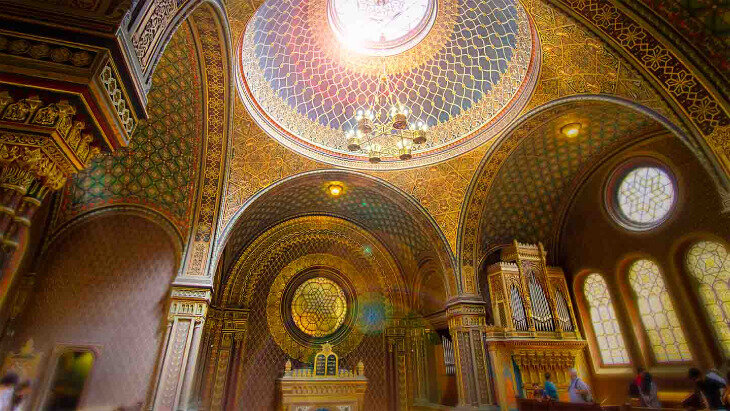

21 min read
A snapshot of Prague’s Jewish history and legacy.
Historically, Prague was the capital of Bohemia and is today located in the Czech Republic. Jewish life in Prague has been documented at least as early as 970 C.E. Jewish merchants at Prague markets are mentioned in a report by a Jewish merchant from Cordoba, Abraham ibn Jacob. By the end of the 11th century, a Jewish community had been fully established in Prague.
In 1096, the community was attacked by Crusaders, and hundreds of Jews were murdered. The community as a whole was again attacked during the siege of the Prague Castle in 1142 when the oldest synagogue in Prague and sections of the Jewish Quarter were burned down.
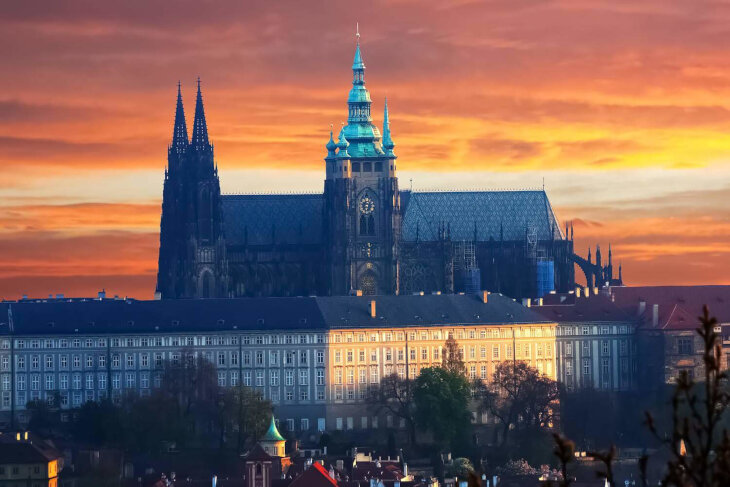 Prague Castle
Prague Castle
After the siege, Jews were required to live on the right bank of the Vltava in an area that eventually became Prague's Jewish ghetto, the Josefov. During this time, Jews were very limited in their movements. By day the doors to the ghetto were open, but in the evening and on festivals, the gates of the ghetto were locked.
The situation did not improve in the early 13th century. In 1215, the Fourth Lateran Council mandated that Jews must wear distinctive clothes, were prohibited from holding public office, and were limited in the amount they could charge for interest on loans. Catholic antisemitism was the norm for the Jews of Prague.
Things began to change at the end of the 13th century under King Otakar II. He issued a Royal Charter in 1254, which stated that the Jews were protected as money lenders and servants of the king and were required to pay high taxes and occasional supply loans to the royal treasury. More importantly, regarding the prevalent Christian antisemitism, the Royal Charter protected the Jews from persecution. It refuted the blood libel myth, prohibited violence against Jews, their property, synagogues, and cemeteries, and outlawed all forced baptisms in the kingdom.
The conflict between the church and nobility would continue for centuries over the status of the Jews and their possessions.
The Church was furious at this infringement on their power and issued complaints against King Otakar II. The king disregarded their complaints and defended his charter by stating that the Jews were official servants of his treasury and thus fell under his control and protection. This conflict between the church and nobility would continue for centuries over the status of the Jews and their possessions.
Life for the Jews in Prague flourished, and there was Jewish scholarship and prosperity in the community. In the immediate aftermath of the Royal Charter, the Jewish Quarter was established as an autonomous district where Jews were permitted to govern most of their internal matters. The Altneuschul - the oldest remaining shul in Europe today - was built in 1270. Jewish life would center around this beautiful building; for many, it represented the unity of the Jews of Bohemia.
 The Altneuschul - the oldest remaining shul in Europe today
The Altneuschul - the oldest remaining shul in Europe today
Some of the most outstanding Jewish leaders resided in Prague at this time. At the beginning of the 13th century, the Jewish community was led by a great leader, Rabbi Avraham ben Azriel, well-known for his work, Arugas Habosem. His student was the famous Rabbi Yitzchak ben Moshe, also known as the Or Zaru'a after the title of his most famous work, a significant commentary on the Talmud.
 King Charles IV, statue in Prague
King Charles IV, statue in Prague
King Charles IV ruled from 1356-1378. He used the Jews to benefit his treasury, at times granting them rights if that were useful for him, and at other times, using their misfortune for his gain. In 1357, he canceled all debts owed to the Jews of his lands to appease his noblemen and strengthen his rule.
[This act of canceling non-Jewish debt owed to Jews was especially popular in Europe, as the Jews were the established moneylenders of the continent. Historically, this reality existed out of coercion, not a choice. Christian law forbade taking interest, yet loans were necessary to fund wars and government projects, so the church required Jews to take the role of moneylending. Since Jews were also forbidden by law to serve in most other professions - including medicine, owning property, and as artisans - this was one of the only fields remaining to them. It was a profession wrought with danger, as it was very appealing to cancel debts owed to Jews by murdering or expelling them, or having the government cancel all debts to Jews, as King Charles IV did in 1357.]
One of the most prominent Jews in Prague at the time was a man by the name of Lazar. In gratitude to Lazar for his frequent loans to the royal treasury, he was given a tax amnesty in the years 1350 to 1352. The most significant sign of Lazar's influence was that he was granted the privilege of living outside the Jewish Quarter. After the death of Lazar, Charles IV claimed his home for one of the first sites of Charles University, the oldest university in Central Europe.
As was so often the case for the Jews of Europe, there were times of stability and times of horrific antisemitism. Jews knew not to get too comfortable, for history had shown them that expulsion or attacks could be just around the corner.
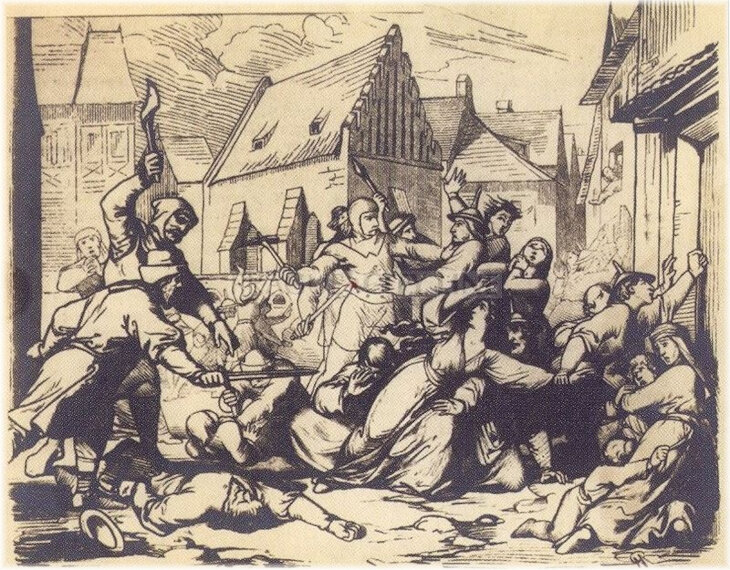 Deadly Easter pogrom in Prague, 1389
Deadly Easter pogrom in Prague, 1389
Prague was devastated by a pogrom in 1389. On Easter that year, which coincided with Passover, Jews were accused of “vandalizing the eucharistic wafer” and, as a result, 3,000 Jewish men, women, and children were cruelly murdered in the streets, homes, and synagogues of the ghetto. One of the few survivors, the great Torah Scholar Rabbi Avigdor Kara (whose tomb is preserved in the Old Jewish Cemetery), saw his father murdered. He wrote a moving prayer, "Es kol ha-tela'ah" describing the attack, which is read yearly in Prague on Yom Kippur. In the aftermath of the pogrom, many Jews fled Prague for Poland and Hungary.
The situation for Prague's Jews fluctuated throughout the 15th century, but there was a brief respite from Catholic persecution under the Hussites.
The Hussites were Bohemian religious separatists who followed the teachings of Jan Hus, a preacher who was burned at the stake in 1415 for criticizing the corruption of the Church. From 1419 to 1436, the Hussites waged war to attempt to gain sovereignty in the Kingdom of Bohemia. During their battles, they protected the Jews against persecution by the Church.
The Hussites were fascinated by the Jews and regarded the Jews as their allies, especially since they shared the common experience of suffering caused by the Church. The Jews, for their part, helped the Hussites in building fortifications at the castle of Vysehrad in 1420. Yet, despite the significant improvements, life under the Hussites was not all bliss. During their reign, pogroms erupted in Prague in 1421 and 1422, leading many Jews to flee to Poland.
An unforeseen consequence of the Hussite wars was the weakening of royal power in favor of the nobility. As a result, Jews in the 15th century could not be as sure of the king's ability to protect them and ended up paying tax money to as many as three different administrations. In much of Moravia and Bohemia, Jews were expelled at the whims of the local governments. Generally, the situation was different in Prague. As long as the tax revenues kept flowing, Jews lived in relative peace.
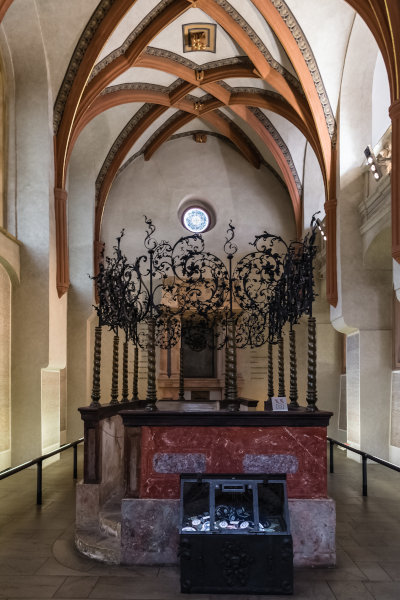 The Pinchas Synagogue was first built for the Horowitz family
The Pinchas Synagogue was first built for the Horowitz family
During the 1400’s, a third synagogue was added to the Jewish Quarter. Built by the Horowitz family, it was a private prayer hall that later became one of the leading synagogues of the ghetto, known as the Pinchas Synagogue.
The first Hebrew press was established in Prague at this time by Gershon ben Shlomo HaCohen. Its Passover Haggadah became the European model for subsequent haggadahs, and by 1512, Prague was the leading center for Hebrew printing north of Italy.
The 16th century became known as the age of the Prague Renaissance. Artisans and intellectuals came from all over Europe and assembled in Prague.
The Jewish population also increased, and between 1522 to 1541, the Jewish population of Prague almost doubled. Many Jewish refugees expelled from Moravia, Germany, Austria, and Spain came to Prague. During this period, the ghetto expanded, and Jews were permitted to acquire lands adjacent to the ghetto to build homes. The Jewish Quarter officially became the ghetto, though this was not marked by any known legislation.
In 1541, a struggle between Ferdinand I and the Burghers resulted in a Burgher demand that Jews be expelled from Prague, and Ferdinand I expelled the Jews for two years. Another temporary removal of the Jews of Prague took place in 1557. Following Ferdinand's death in 1564, the situation improved for Prague Jewry.
The Golden Age of Prague was primarily during the reigns of Maximilian (1564-1576) and Rudolf II (1576-1612). Emperor Rudolf II was considered by the Catholic world a weak leader since he devoted much energy to the arts and sciences.
In 1584, Emperor Rudolf II moved his imperial seat and residence to Prague, which gave his new capital an economic and population boom.
Under his rule, the Jews were permitted economic and religious freedom. He promised Jews permanent safety in Prague and Bohemia and issued decrees protecting the Jews from the hostility of the noblemen. He permitted Jews to become artisans and ensured that the royal court judged all disputes between Jews and Christians. In 1599 Rudolf II even exempted the Jews from all city taxes. Due to these economic policies, the Jews of Prague could finally branch beyond moneylending and support themselves through other means.
During the Golden Age of Prague, the community grew to a population of over 3,000 by the end of the 16th century and to over 6,500 by the end of the 17th century. Due to the favorable situation, Jews from around the world came and settled in the Jewish Quarter, and some of the most outstanding Jewish leaders of Europe lived in Prague then.
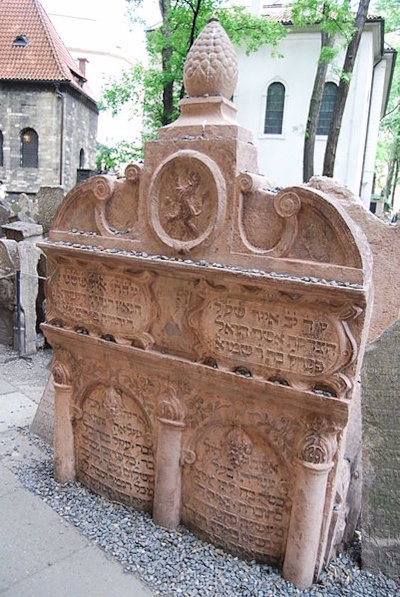 Tombstone of the Maharal in the Old Jewish Cemetery, Prague (Photo: Wikimedia)
Tombstone of the Maharal in the Old Jewish Cemetery, Prague (Photo: Wikimedia)
The Maharal, Rabbi Yehuda Loew, was the chief rabbi of Prague. He was a towering giant in Torah and Kabbalah and a fearless leader of European Jewry during the 16th century. He is known for his works on Jewish philosophy and for the Gur Aryeh al HaTorah, a super-commentary on Rashi. The Maharal was also an outstanding rabbinic leader and established the guidelines for Prague's first Chevra Kadisha (Jewish Burial Society). He published more than 50 religious and philosophical books and became the center of legends as the mystical miracle worker who created the Golem. (Whether the Golem actually existed or not is unclear, but the greatness of the Maharal is entirely independent of the Golem story.) The Maharal had positive relations with Rudolph II and was invited to his castle on occasion.
The Maharal’s great students were the next generation's leaders, among them the Kli Yakar (Rabbi Efraim Shlomo ben Aharon of Luntshits), the Tosfos Yom Tov (Rabbi Yom Tov Lipmann Heller), Rabbi Shabtai Sheftel ben Akiva Horowitz, and the Shelah (Rabbi Yeshayah ben Avraham Horowitz).
Another well-known Jewish figure of the time was Rabbi Dovid Shlomo Ganz (1541-1613), a mathematician, historian, and astronomer. He corresponded with royal court astronomers Tycho Brahe and Johannes Kepler. Rabbi Ganz was a student of both the Rema, Rabbi Moshe Isserles, and the Maharal. He wrote multiple works on Torah, of which the most well-known is his Tzemach David, published in Prague in 1592. The book is divided into two parts: the first is an accounting of Jewish history and the second part is general world history.
Mordechai Maisel (1528–1601) was Rudolf's court Jew and banker and helped him finance a war against Turkey. He was a brilliant financier and an outstanding philanthropist on behalf of his people. He funded buildings for the Jewish community, including numerous synagogues and mikvahs. He paid for the paving of the muddy paths of the ghetto with cobblestones. Not only did he contribute money to Prague causes, but he also donated Torah scrolls to Jewish communities worldwide, including Jerusalem.
The devastation of the Thirty Years War (1618-1648) brought mixed fortune for the Jews of Prague. On the one hand, Emperor Ferdinand II, desperate for economic support in the war, took great pains to ensure the safety of the Jews. Although his troops ransacked Prague after the Battle of White Mountain, the emperor prohibited them from harming the Jewish Quarter and even had guards posted outside their homes. To the Jews of Prague, this was nothing short of a miracle. To commemorate this momentous event, they established the 14th of the Hebrew month of Cheshvan - the day the invasion began - as a Purim of Prague.
 The Jewish Cemetery of Prague
The Jewish Cemetery of Prague
The representative of Prague's Jewish Community during the Thirty Years' War was the financier Ya'akov Bassevi of Treuenburg (1570–1634). He was also the first Jew knighted in Europe.
Yet, as his financial needs increased, Ferdinand II made the continuation of Jewish privilege dependent on the Jews’ increased taxes and providing the emperor with a loan of 24,000 gulden. It was these tax requirements that, in 1627, led some resentful Jews to turn on their great Rabbi Yomtov Lipman Heller, who was forced out of Prague and eventually settled in Cracow.
After the Thirty Years' War, measures were taken by the state authorities to reduce the number of Jews and to segregate them more strictly in a ghetto. Implementation of these measures was prevented in 1680 by an outbreak of plague, which took the lives of more than 3,500 Jews.
To prevent further Jewish population growth, Emperor Charles VI (1711–1740) issued the cruel Familiants Law in 1726 and 1727. The Familiants Laws decreed that only 8,541 Jewish families would be tolerated in Bohemia and 5,106 in Moravia. Only the eldest son in a Jewish family would be given the right to marry. All other sons were forced to emigrate, try to marry illegally in the countryside, or die single. This would have a devastating effect on Bohemian Jewry for the next 120 years. This legislation remained in effect up to the Revolution of 1848.
The position of the Jews under Emperor Charles VI was even worse when his daughter, Maria Theresa, became empress in 1740. Empress Maria Theresa, an ardent Catholic and antisemite, accused the Jews of siding with the Prussians during her battles for the "Hapsburg Heritage." She decreed the expulsion of the Jews from Bohemia in 1744 and Moravia in 1745. Although the Prague City Council opposed the action, the Jews were forced out of Prague during a severe winter in January 1745. For a few years, they were permitted to remain in Bohemian villages at a distance of at least two days from Prague.
But Empress Maria Theresa had not counted on the devastating effect this would have on Prague’s economy. Jews had been moneylenders, suppliers of raw materials, and good customers in Prague markets. Without the Jews, the economy was in shambles.
 Interior of the Spanish Synagogue
Interior of the Spanish Synagogue
In 1748, the empress rescinded her decree, and Jews were permitted to return to Prague. To avoid humiliation, she imposed a severe annual "toleration tax" of 204,000 guldens on the Jews for the privilege of residing in Prague.
Despite the persecution, Jewish scholarship in Prague continued to flourish. Among the prominent rabbis in the eighteenth century were Rabbi Eliyahu Spira, Rabbi Dovid Oppenheim, and the Noda b'Yehuda, Rabbi Yecḥezkel Landau.
Whereas Empress Maria Theresa's view on the Jews was to expel or convert them, her son, Josef II viewed the Jews as beneficial to the country. He was focused on building the economy and a modern state with the help of the Jews. He also planned to give increased rights to all non-Catholics, with the vision of creating a strong centralized and united country.
 Emperor Josef II
Emperor Josef II
After his mother died in 1780, Emperor Josef II began to implement his more liberal-minded views. However, there were strong reactions from his populace. Some agreed with the emperor in support of the Jews emancipation. Others vehemently opposed, publishing pamphlets depicting the Jews as traitors who murdered Christians and would eventually destroy the monarchy.
In response, Josef II ultimately modified his more ambitious plans.
In October 1781, Josef II issued the Edict of Tolerance for the Jews of Bohemia, and in 1782 for Moravian Jewry. Although it was not a declaration of equal rights, the Edict of Tolerance gave Jews their first opportunity to enter the larger world. The Jews appreciated Joseph II so much that they named the Jewish Quarter, Josefov after him, and this name still exists today.
There are several points to stress about the Edict of Tolerance. This was not a Civil Rights Act. Although Josef II boasted that his Edict granted the Jews "near-equality," in truth, this was an exaggeration.
The Edict did state that Jews no longer had to wear special identifying marks. Yet, the Edict continued to deny citizenship to the Jews and forbade them from becoming master craftsmen. The Familiants Law was upheld. Jews continued to be confined to the ghetto until 1849, and complete emancipation would come only in 1867.
As part of its goal to integrate the Jews into the state's economy, the Edict set requirements that essentially decreased the Judaism of the Jews. The use of Hebrew in all business documents and secular transactions was forbidden. Universities were open to Jews, and Jews were encouraged to start factories and engage in agriculture, although they were still forbidden to own land. Jews were also strongly encouraged to close their exclusively Jewish schools, and open new schools that included secular studies.
With restrictions placed on their Jewish language, education, communal authority, and even names, the Crown felt that Jews would be more integrated and more valuable to the economy of the monarchy.
The emperor was most candid in his observation that the purpose of the Edict was "to make [the Jews] useful to the state."
Subsequent decrees continued to send Jews down the road of integration and assimilation. In 1784, the authority of the beis din (Jewish court of law) was abolished except in religious and marital matters, and disputes were required to be tried in secular courts. In 1786, a law decreed that only graduates of secular elementary schools would be permitted to marry. In 1787, Jews were required to adopt German surnames. With restrictions placed on their Jewish language, education, communal authority, and even names, the Crown felt that Jews would be more integrated and more valuable to the economy of the monarchy.
From the earliest signs of emancipation, debates have raged about whether the reforms were good for the Jewish community or the beginning of its destruction.
On the one hand, the state of constant persecution was devastating. On the other hand, with integration encouraged and demanded from the outside, Jewish identity faced a challenge from which it would never quite recover. Ironically, Jews had survived as a nation and maintained their unique identity and role through 17 centuries of almost unceasing attacks and expulsions. Yet, when the legal barriers that held them back began to disappear, Jews found that the most successful way to enter European society was to abandon their Jewish heritage. The nineteenth century ushered in an age of assimilation that had no precedent in Jewish history.
 Rabbi Yechezkel Landau
Rabbi Yechezkel Landau
The greatest rabbi in Bohemia in the 18th century, Rabbi Yechezkel Landau (1713-1793), was elected chief rabbi one year after a catastrophic fire in Prague in 1754. He had succeeded in building the Prague Jewish community into one of the most vibrant Jewish communities in Central Europe.
Rabbi Landau foresaw that the Edict of Tolerance would lead the Jews on a path away from the Torah. Despite his concerns, he realized he would have to compromise in the face of the monarchy's steadfast determination to "educate" the Jews. After he was given a role in planning the schools and was assured that the most radical plans would not be implemented, Rabbi Landau gave the schools his tacit approval.
 The Synagogue of the Jubilee was constructed outside the old Jewish quarter in the Nove Mesto (New City), in 1905-06, celebrating the integration of Jews into Prague society at the beginning of the century.
The Synagogue of the Jubilee was constructed outside the old Jewish quarter in the Nove Mesto (New City), in 1905-06, celebrating the integration of Jews into Prague society at the beginning of the century.
Jewish emancipation was a gradual process. The ghetto was abolished in 1852, and Josefov became a district of Prague. In 1852, Jews were allowed to own property, and in 1859, to own land. Unfortunately, Rabbi Landau’s concerns were well-founded. Most of Prague Jews had assimilated in the aftermath of the emancipation decrees. By 1930, Prague had a 30% intermarriage rate, one of the highest in all of Europe.
In the late 1930s, Jewish refugees escaping the Nazis fled to the Prague area from Germany, Austria, and Sudetenland. Whereas in 1930, 35,463 Jews were living in Prague, there were nearly 55,000 Jews there in 1940.
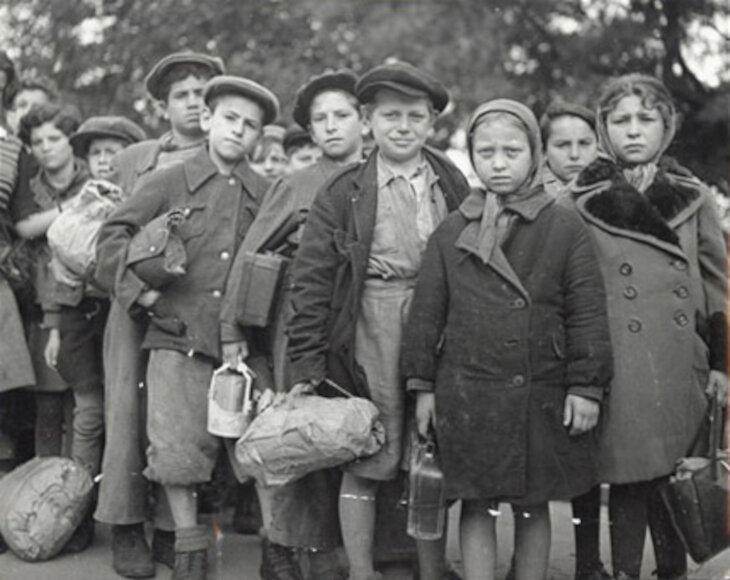 Polish Jewish children, many of whom are orphaned, en route to safety in American Zones of Austria and Germany. Prague, Czechoslovakia. c. 1946. (JDC Archives)
Polish Jewish children, many of whom are orphaned, en route to safety in American Zones of Austria and Germany. Prague, Czechoslovakia. c. 1946. (JDC Archives)
On March 14, 1939, Slovakia declared independence from Prague and signed the Treaty of Protection with Nazi Germany. The next day, Germany occupied the Czech lands. At the outbreak of World War II, Prague was one of the largest Jewish communities in Europe. At the end of the war, two-thirds of the Jewish population of Prague had been murdered in the Holocaust. Over 97,000 Czech Jews perished in the Holocaust, of which 15,000 were Czech Jewish children.
 The beautiful Spanish Synagogue was built in 1868 in Moorish style by Vojtěch Ignác Ullmann and Josef Niklas
The beautiful Spanish Synagogue was built in 1868 in Moorish style by Vojtěch Ignác Ullmann and Josef Niklas
Despite the destruction wrought by the Nazis on the Jews and their community, much of Prague’s Jewish architecture remains. How did these buildings of the Jewish Quarter manage to survive? It is believed that Hitler wanted to establish a ‘Museum of an Extinct Race’ in Prague once the war was over. He had hundreds of thousands of Jewish artifacts transported to Prague from all over Europe.
Following the war, approximately 5,000 Jewish survivors returned to Prague. By 1949, half of them had emigrated to Israel.
In 1945, the Communist Party took power and in the coming decades, Jewish life was stifled and emigration to Israel was forbidden as of 1949. Jews who remained in Prague kept their Jewish identity a secret.
In 1968 a Slovak Communist named Alexander Dubcek became the party leader. In a movement called Prague Spring, he began to introduce sweeping reforms to make the government more democratic. He ordered an end to censorship and encouraged open discussion about the political direction of Czechoslovakia. Many young Jews were involved in the events of the Prague Spring. Additional, for the first time since World War II, they were able to openly ask questions about the Holocaust and their Jewish heritage.
The Soviet Union disapproved of these changes and invaded Czechoslovakia in August 1968. Civilians were shot dead in the street, and 3,400 Jews fled the country. The secret police kept a close eye on the remaining Jewish community, and many Jewish university professors lost their jobs. From 1968 to 1989, the Holocaust was forbidden to be mentioned and survivors were required to be silent on the topic.
When change began to sweep through Eastern Europe in the late 1980s, Czechs joined the movement. Demonstrations resulted in the resignation of the Communist party leadership in November 1989. Alexander Dubcek, the Prague Spring reformer, was elected chairman of parliament. In June 1990, the country held its first free election since 1946. On January 1, 1993, the country split into Slovakia and the Czech Republic. Prague was adopted as the capital of the Czech Republic.
Today, the Federation of Jewish Communities estimates that there are between 3,000 and 5,000 Jews in the Czech Republic, of which 1,600 live in Prague.
The beauty of Prague's Jewish buildings and the old ghetto remain visited by countless tourists. Sadly, Prague, which had been for a time the most vibrant, influential and populated Jewish city in the world, has essentially become a museum of testimony to earlier greatness. Yet, the works produced, and the Torah taught by its great leaders continue to live on for eternity. They are Jewish Prague’s legacy.
